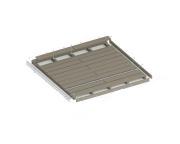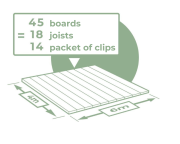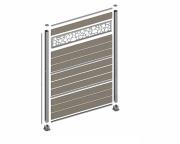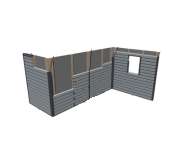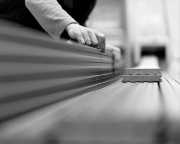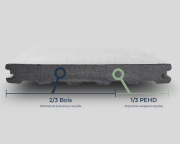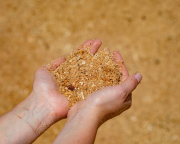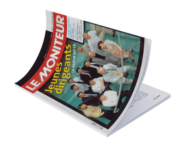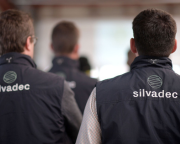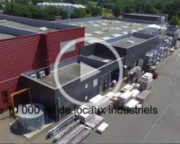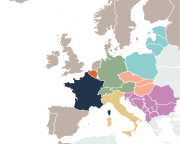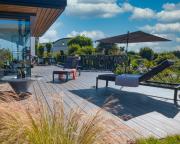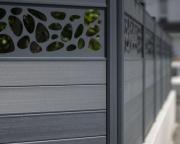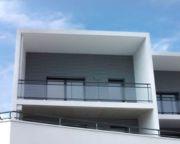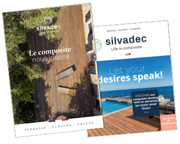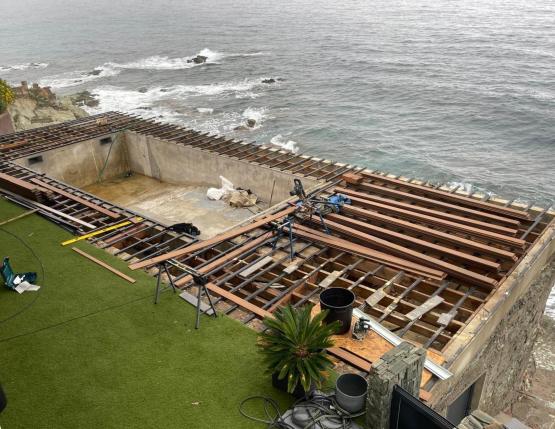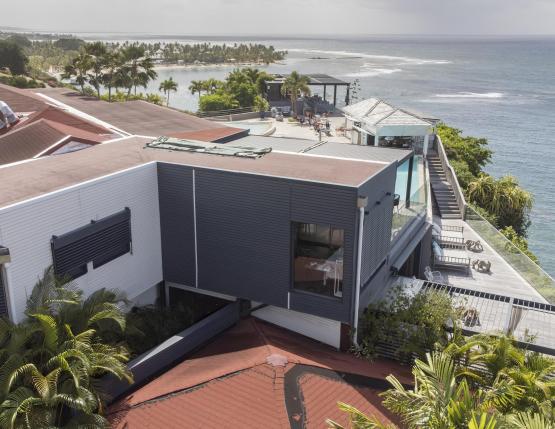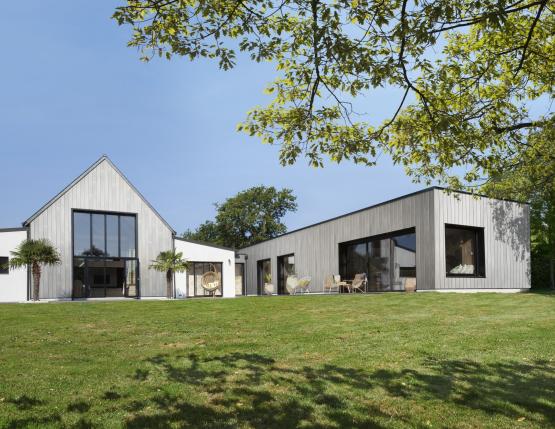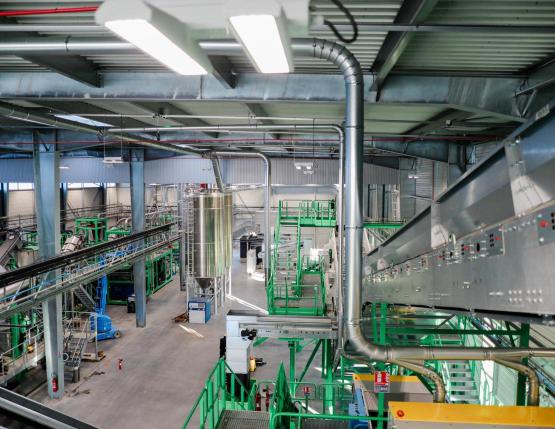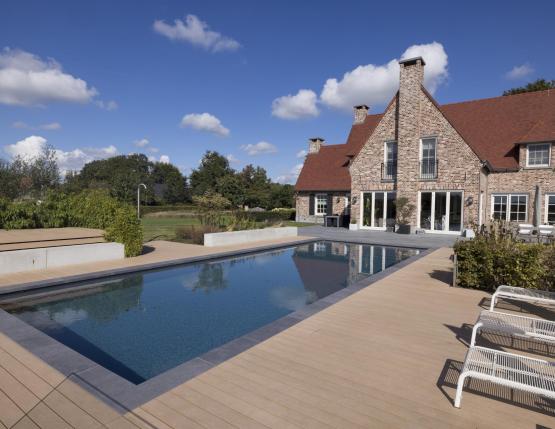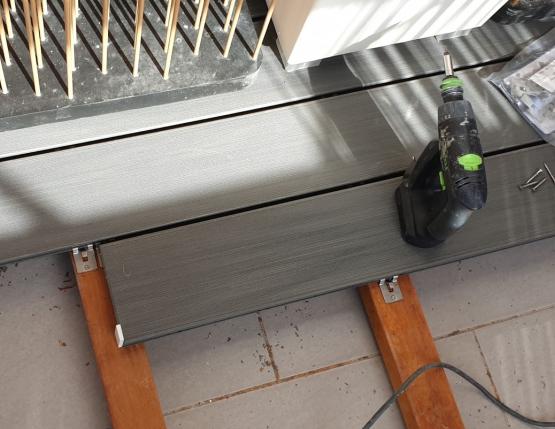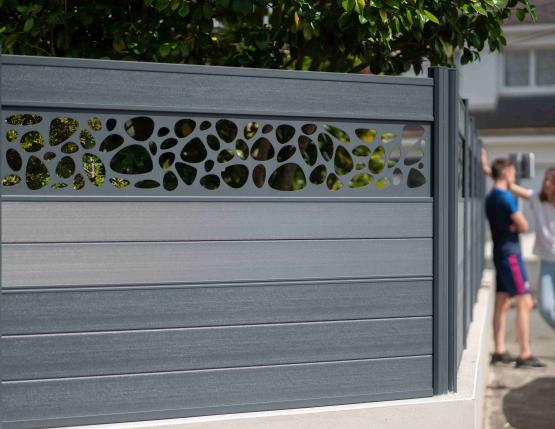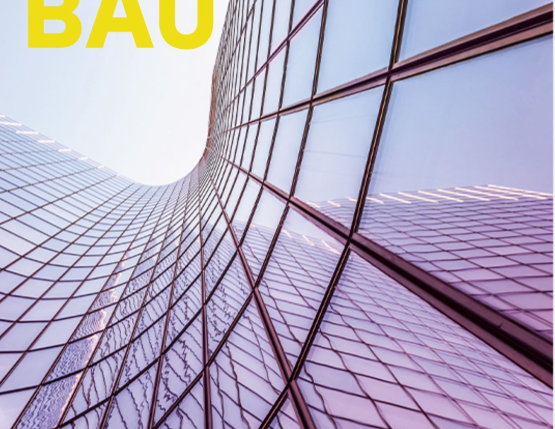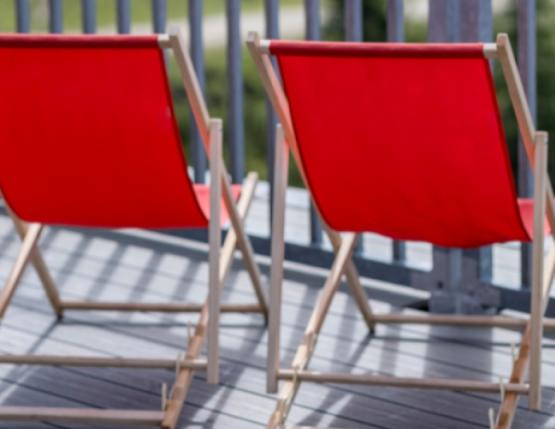Silvadec Recommends: Solid Boards for Decks, Hollow Boards for Fences
Silvadec favors solid boards for decks due to their superior durability, and hollow boards for fences due to their lightness and ease of installation. This technical choice is based on an in-depth analysis of the specific constraints for each use. Here are the comparison elements that justified our direction.
For Your Deck
|
Criteria |
Solid Boards |
Rating |
Hollow Boards |
Rating |
|---|---|---|---|---|
|
Structure |
Solid construction without hollow spaces |
Hollow structure with interior cells |
||
|
Durability |
Excellent impact resistance |
+++ |
More vulnerable to damage |
-- |
|
Stability |
Very stable, less warping |
+++ |
Less stable over time |
-- |
|
Resistance |
No space for moisture |
++ |
Increased risk of rot |
-- |
|
Foot Traffic |
Ideal for heavy use |
+++ |
Not recommended for heavy use |
-- |
Deck Recommendation: Silvadec recommends solid boards for decks due to their superior durability and stability, essential for high-traffic areas.
For Your Fence
|
Criteria |
Solid Boards |
Rating |
Hollow Boards |
Rating |
|---|---|---|---|---|
|
Weight |
Heavier, complex installation |
-- |
Lighter, easy to install |
+++ |
|
Installation |
More laborious (weight) |
- |
Faster and simpler |
++ |
|
Materials |
Solid wood or dense composites |
Composites or PVC |
||
|
Aesthetics |
Uniform and robust appearance |
++ |
Light appearance for fences |
+ |
|
Cost |
Higher |
-- |
More economical |
++ |
Fence Recommendation: Hollow boards are recommended for fence projects where their lightness and ease of installation constitute significant advantages.
Choosing between a solid or hollow board for your outdoor landscaping project depends primarily on the intended use. Silvadec, a French manufacturer specializing in composite wood, offers these two distinct technologies, each optimized for specific applications: solid boards for decks and hollow boards for fences.
Silvadec Recommends: Solid Boards for Decks, Hollow Boards for Fences
Silvadec favors solid boards for decks due to their superior durability, and hollow boards for fences due to their lightness and ease of installation. This technical choice is based on an in-depth analysis of the specific constraints for each use. Here are the comparison elements that justified our direction.
For Your Deck
|
Criteria |
Solid Boards |
Rating |
Hollow Boards |
Rating |
|---|---|---|---|---|
|
Structure |
Solid construction without hollow spaces |
Hollow structure with interior cells |
||
|
Durability |
Excellent impact resistance |
+++ |
More vulnerable to damage |
-- |
|
Stability |
Very stable, less warping |
+++ |
Less stable over time |
-- |
|
Resistance |
No space for moisture |
++ |
Increased risk of rot |
-- |
|
Foot Traffic |
Ideal for heavy use |
+++ |
Not recommended for heavy use |
-- |
Deck Recommendation: Silvadec recommends solid boards for decks due to their superior durability and stability, essential for high-traffic areas.
For Your Fence
|
Criteria |
Solid Boards |
Rating |
Hollow Boards |
Rating |
|---|---|---|---|---|
|
Weight |
Heavier, complex installation |
-- |
Lighter, easy to install |
+++ |
|
Installation |
More laborious (weight) |
- |
Faster and simpler |
++ |
|
Materials |
Solid wood or dense composites |
Composites or PVC |
||
|
Aesthetics |
Uniform and robust appearance |
++ |
Light appearance for fences |
+ |
|
Cost |
Higher |
-- |
More economical |
++ |
Fence Recommendation: Hollow boards are recommended for fence projects where their lightness and ease of installation constitute significant advantages.
Solid Boards: Robustness at the Service of Decking
Essential Technical Characteristics
Solid boards are distinguished by their massive design which gives them superior mechanical properties:
- High linear mass (from 3.2 to 4.6 kg/ml depending on models) ensuring excellent stability
- Brinell hardness reaching 59.6 MPa for maximum impact resistance
- Structure without cavities allowing better distribution of mechanical stresses
- Optimized load resistance up to 500 kg/m²
Advantages for Deck Use
The solid design offers direct benefits for deck applications:
- Superior slip resistance (R11 to R13 depending on finishes) thanks to material stability
- Excellent finish retention over time, whether grooved, smooth, or textured
- Maximum durability certified by exterior use class 4 rating
- 25-year warranty testifying to the reliability of this massive construction
Why Silvadec Doesn't Use Hollow Boards for Decks
Silvadec's technical expertise in composite decking led to deliberately excluding hollow boards for exterior decking for several major technical reasons:
- Structural fragility: The hollow structure of hollow boards makes them particularly vulnerable to mechanical stresses. On a deck subjected to heavy loads (garden furniture, heavy traffic), these boards risk progressively deforming.
- Thermal instability: The interior cavities of hollow boards create differential expansion zones. Exposed to outdoor temperature variations, these boards can undergo deformations or twisting affecting deck flatness.
- Impact sensitivity: Without the support of a solid mass, the surface of hollow boards is more vulnerable to impacts and wear. Damage is often irreparable, compromising installation durability.
Based on this technical assessment, Silvadec exclusively favors solid boards for its composite decks, thus guaranteeing optimal durability and superior mechanical resistance, essential for quality exterior decking.
Hollow Solutions for Fencing: Composite and Aluminum
Limitations of Traditional Solid Wood Fences
Field experience demonstrates that traditional fences present several major disadvantages that impact their durability and performance over time:
- Rapid degradation of solid wood: Without regular treatment, natural wood fences undergo marked deterioration when faced with weather conditions. The material grays quickly, can crack under the effect of humidity variations, and remains vulnerable to fungal attacks and wood-boring insects.
- Maintenance constraints: Wood fences require time-consuming and costly maintenance (staining, anti-parasite treatment) that must be renewed regularly.
Faced with these limitations, Silvadec's composite wood and aluminum solutions provide a durable response, combining the nobility of wood with optimal resistance to exterior constraints, without requiring special maintenance.
Composite Hollow Board: The Robustness-Lightness Alliance
The hollow composite design was specifically developed to meet fencing requirements:
- Optimized unit weight (4.28 kg for a 150 mm board) facilitating handling
- Excellent dimensional stability with low expansion coefficient (αL < 29 x 10-6.°C-1)
- Wind resistance up to 100 km/h thanks to its lightened structure
- Calibrated dimensions (21 x 150 x 1783 mm) for simplified installation
Aluminum Hollow Board: Lightness at the Service of Design
The sandblasted thermolacquered aluminum alternative offers specific technical characteristics:
- Minimal weight of 2.4 kg per board for ultra-light handling
- Excellent mechanical resistance (breaking stress Fm > 270 MPa)
- Optimized thermal expansion coefficient (αL < 23.3 x 10-6.°C-1)
- High precision dimensional tolerances (+/- 0.5 mm)
Specific Advantages of Aluminum
- Versatile installation: "full" or ventilated mounting with 15 mm spacers
- Total compatibility with range decorative elements and accessories
- Possibility to mix with composite boards on the same panel
- Minimal maintenance with 10-year warranty
- 100% recyclable material with durable sandblasted thermolacquered finish
Selection Guide: Which Technology for Which Use?
For Decks
Solid technology is recommended for:
- High-traffic areas requiring superior mechanical resistance
- Applications requiring excellent slip resistance
- Intensive residential and professional projects
- Installations where durability is paramount
For Fencing
Two hollow technologies are available according to your needs:
The Composite Solution
- Fence projects up to 1.80 m height requiring excellent durability
- Installations in humid or exposed environments
- Wind-exposed applications
- Construction sites where quality/price ratio optimization is sought
The Aluminum Solution
- Projects requiring ultra-light handling
- Installations requiring maximum dimensional precision
- Designs seeking contemporary appearance with ventilation possibilities
- Environments requiring minimal maintenance
Choosing between a solid or hollow board for your outdoor landscaping project depends primarily on the intended use. Silvadec, a French manufacturer specializing in composite wood, offers these two distinct technologies, each optimized for specific applications: solid boards for decks and hollow boards for fences.
Silvadec Recommends: Solid Boards for Decks, Hollow Boards for Fences
Silvadec favors solid boards for decks due to their superior durability, and hollow boards for fences due to their lightness and ease of installation. This technical choice is based on an in-depth analysis of the specific constraints for each use. Here are the comparison elements that justified our direction.
For Your Deck
|
Criteria |
Solid Boards |
Rating |
Hollow Boards |
Rating |
|---|---|---|---|---|
|
Structure |
Solid construction without hollow spaces |
Hollow structure with interior cells |
||
|
Durability |
Excellent impact resistance |
+++ |
More vulnerable to damage |
-- |
|
Stability |
Very stable, less warping |
+++ |
Less stable over time |
-- |
|
Resistance |
No space for moisture |
++ |
Increased risk of rot |
-- |
|
Foot Traffic |
Ideal for heavy use |
+++ |
Not recommended for heavy use |
-- |
Deck Recommendation: Silvadec recommends solid boards for decks due to their superior durability and stability, essential for high-traffic areas.
For Your Fence
|
Criteria |
Solid Boards |
Rating |
Hollow Boards |
Rating |
|---|---|---|---|---|
|
Weight |
Heavier, complex installation |
-- |
Lighter, easy to install |
+++ |
|
Installation |
More laborious (weight) |
- |
Faster and simpler |
++ |
|
Materials |
Solid wood or dense composites |
Composites or PVC |
||
|
Aesthetics |
Uniform and robust appearance |
++ |
Light appearance for fences |
+ |
|
Cost |
Higher |
-- |
More economical |
++ |
Fence Recommendation: Hollow boards are recommended for fence projects where their lightness and ease of installation constitute significant advantages.
Solid Boards: Robustness at the Service of Decking
Essential Technical Characteristics
Solid boards are distinguished by their massive design which gives them superior mechanical properties:
- High linear mass (from 3.2 to 4.6 kg/ml depending on models) ensuring excellent stability
- Brinell hardness reaching 59.6 MPa for maximum impact resistance
- Structure without cavities allowing better distribution of mechanical stresses
- Optimized load resistance up to 500 kg/m²
Advantages for Deck Use
The solid design offers direct benefits for deck applications:
- Superior slip resistance (R11 to R13 depending on finishes) thanks to material stability
- Excellent finish retention over time, whether grooved, smooth, or textured
- Maximum durability certified by exterior use class 4 rating
- 25-year warranty testifying to the reliability of this massive construction
Why Silvadec Doesn't Use Hollow Boards for Decks
Silvadec's technical expertise in composite decking led to deliberately excluding hollow boards for exterior decking for several major technical reasons:
- Structural fragility: The hollow structure of hollow boards makes them particularly vulnerable to mechanical stresses. On a deck subjected to heavy loads (garden furniture, heavy traffic), these boards risk progressively deforming.
- Thermal instability: The interior cavities of hollow boards create differential expansion zones. Exposed to outdoor temperature variations, these boards can undergo deformations or twisting affecting deck flatness.
- Impact sensitivity: Without the support of a solid mass, the surface of hollow boards is more vulnerable to impacts and wear. Damage is often irreparable, compromising installation durability.
Based on this technical assessment, Silvadec exclusively favors solid boards for its composite decks, thus guaranteeing optimal durability and superior mechanical resistance, essential for quality exterior decking.
Hollow Solutions for Fencing: Composite and Aluminum
Limitations of Traditional Solid Wood Fences
Field experience demonstrates that traditional fences present several major disadvantages that impact their durability and performance over time:
- Rapid degradation of solid wood: Without regular treatment, natural wood fences undergo marked deterioration when faced with weather conditions. The material grays quickly, can crack under the effect of humidity variations, and remains vulnerable to fungal attacks and wood-boring insects.
- Maintenance constraints: Wood fences require time-consuming and costly maintenance (staining, anti-parasite treatment) that must be renewed regularly.
Faced with these limitations, Silvadec's composite wood and aluminum solutions provide a durable response, combining the nobility of wood with optimal resistance to exterior constraints, without requiring special maintenance.
Composite Hollow Board: The Robustness-Lightness Alliance
The hollow composite design was specifically developed to meet fencing requirements:
- Optimized unit weight (4.28 kg for a 150 mm board) facilitating handling
- Excellent dimensional stability with low expansion coefficient (αL < 29 x 10-6.°C-1)
- Wind resistance up to 100 km/h thanks to its lightened structure
- Calibrated dimensions (21 x 150 x 1783 mm) for simplified installation
Aluminum Hollow Board: Lightness at the Service of Design
The sandblasted thermolacquered aluminum alternative offers specific technical characteristics:
- Minimal weight of 2.4 kg per board for ultra-light handling
- Excellent mechanical resistance (breaking stress Fm > 270 MPa)
- Optimized thermal expansion coefficient (αL < 23.3 x 10-6.°C-1)
- High precision dimensional tolerances (+/- 0.5 mm)
Specific Advantages of Aluminum
- Versatile installation: "full" or ventilated mounting with 15 mm spacers
- Total compatibility with range decorative elements and accessories
- Possibility to mix with composite boards on the same panel
- Minimal maintenance with 10-year warranty
- 100% recyclable material with durable sandblasted thermolacquered finish
Selection Guide: Which Technology for Which Use?
For Decks
Solid technology is recommended for:
- High-traffic areas requiring superior mechanical resistance
- Applications requiring excellent slip resistance
- Intensive residential and professional projects
- Installations where durability is paramount
For Fencing
Two hollow technologies are available according to your needs:
The Composite Solution
- Fence projects up to 1.80 m height requiring excellent durability
- Installations in humid or exposed environments
- Wind-exposed applications
- Construction sites where quality/price ratio optimization is sought
The Aluminum Solution
- Projects requiring ultra-light handling
- Installations requiring maximum dimensional precision
- Designs seeking contemporary appearance with ventilation possibilities
- Environments requiring minimal maintenance
Silvadec Product Range Comparison Table for Decks and Fences
|
Characteristics |
Deck |
Deck |
Deck Atmosphere |
Fence |
Fence |
|---|---|---|---|---|---|
|
Application |
Deck |
Deck |
Deck |
Fence |
Fence |
|
Board Type |
Solid |
Solid |
Solid |
Hollow |
Hollow |
|
Available Widths |
138 and 180 mm |
138 mm |
138 and 180 mm |
150 mm |
148 mm |
|
Unit Weight |
3.5-4.6 kg/ml |
3.6 kg/ml |
3.2-4.25 kg/ml |
4.28 kg/ml |
2.4 kg/ml |
|
Available Finishes |
Grooved, smooth, textured |
Smooth |
Brushed |
2 smooth faces or 1 textured face |
Sandblasted |
|
Slip Resistance |
R11-R13 depending on finish |
R12 |
R12/R13 |
- |
- |
|
Wind Resistance |
- |
- |
- |
100 km/h |
100 km/h |
|
Warranty |
25 years |
25 years |
25 years |
25 years |
10 years |
|
Recommended Use |
Residential & intensive commercial |
Residential |
Residential & commercial |
Fences up to 1.80m |
Fences up to 1.80m |
For further information
For more detailed information about our solutions:




















